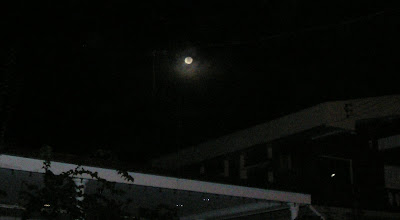Moon will be nearly full, rising earlier Friday night and later Sunday night
 This view of a full moon was photographed by an Expedition 14 crewmember onboard the International Space Station. Earth's horizon and airglow is visible at left.
This view of a full moon was photographed by an Expedition 14 crewmember onboard the International Space Station. Earth's horizon and airglow is visible at left.
If skies are clear Saturday, go out at sunset and look for the giant moon rising in the east. It will be the biggest and brightest one of 2009, sure to wow even seasoned observers.
Earth, the moon and the sun are all bound together by gravity, which keeps us going around the sun and keeps the moon going around us as it goes through phases. The moon makes a trip around Earth every 29.5 days.
But the orbit is not a perfect circle. One portion is about 31,000 miles (50,000 km) closer to our planet than the farthest part, so the moon's apparent size in the sky changes. Saturday night (Jan. 10) the moon will be at perigee, the closest point to us on this orbit.
It will appear about 14 percent bigger in our sky and 30 percent brighter than some other full moons during 2009, according to NASA. (A similar setup occurred in December, making that month's full moon the largest of 2008.)
High tidesTides will be higher, too. Earth's oceans are pulled by the gravity of the moon and the sun. So when the moon is closer, tides are pulled higher. Scientists call these perigean tides, because they occur when the moon is at or near perigee. (The farthest point on the lunar orbit is called apogee.)
This month's full moon is known as the Wolf Moon from Native American folklore. The full moon's of each month are named. January's is also known as the Old Moon and the Snow Moon.
A full moon rises right around sunset, no matter where you are. That's because of the celestial mechanics that produce a full moon: The moon and the sun are on opposite sides of the Earth, so that sunlight hits the full face of the moon and bounces back to our eyes.
At moonrise, the moon will appear even larger than it will later in the night when it's higher in the sky. This is an illusion that scientists can't fully explain. Some think it has to do with our perception of things on the horizon vs. stuff overhead.
Try this trick, though: Using a pencil eraser or similar object held at arm's length, gauge the size of the moon when it's near the horizon and again later when it's higher up and seems smaller. You'll see that when compared to a fixed object, the moon will be the same size in both cases.
source: http://www.msnbc.msn.com/id/28581233/
:: how does this affect BDC?
Full moon means more fishes coming to shore for sales following the high tides. High tides coupled with continuous rain will result in the natural drainage a.k.a. River Sarawak be burdened with too much water. Water from man-made drainage filled up due to their inability to outflow and lower grounds will experience floods. BDC's staffs staying in area outside TSJ or even as resident of TSJ will be faced with floods in two or more ways:
i. their homes are flooded.
ii. part of the routes to the office are flooded.
iii. members of their immediate families are facing flood problems and they have to be good samaritans to the rescue.
iv. difficulty in driving in the heavy rain.
 Puan Korina (second left), member of the Secretariat is laughing at something.
Puan Korina (second left), member of the Secretariat is laughing at something. Representative from STIDC (Pusaka) on her blackberry - organisation with the most lengthy report, oursourcing. Seating beside her is the representative from Bintulu Development Authority - someone we will be chasing after in the near future.
Representative from STIDC (Pusaka) on her blackberry - organisation with the most lengthy report, oursourcing. Seating beside her is the representative from Bintulu Development Authority - someone we will be chasing after in the near future. Lady from Sacofa - dependent on blackberry.
Lady from Sacofa - dependent on blackberry. Masella (sounds like) from Salcra - happy to announce that they are starting their KPI in 2009!
Masella (sounds like) from Salcra - happy to announce that they are starting their KPI in 2009! Second right, Japri Bujang Masli, the Acting CEO of Pustaka, the host for the meeting.
Second right, Japri Bujang Masli, the Acting CEO of Pustaka, the host for the meeting. Inya Pelangi
Inya Pelangi Caroline Cleophas
Caroline Cleophas Puan Noriah (right) - opss camera was a bit scared of her ;p
Puan Noriah (right) - opss camera was a bit scared of her ;p the rest of the gangs.
the rest of the gangs.






